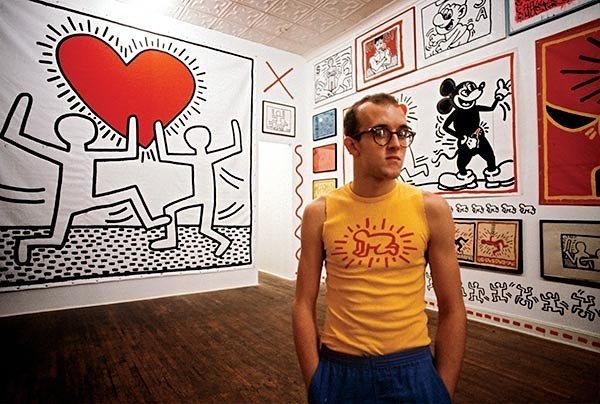Home
Keith Haring: The Art that Transformed America

The American artist, Keith Haring, is renowned for his bright, vibrant artwork that has become a visual representation of the 1980s. His work was heavily influenced by street culture and pop art, and he used it to create pieces that had great cultural significance. From murals in subway stations to galleries around the world, Haring’s art captivated viewers with its unique style and message.
Early Life & Education
Keith Haring was born on May 4, 1958, in Reading, Pennsylvania. He grew up in Kutztown, Pennsylvania with his parents and three younger sisters. As a child, Haring showed an early interest in drawing and art-making. His family encouraged his talents by providing him with colouring books and crayons from an early age.
Haring’s artistic skills were further developed during his high school years at the Ivy School of Professional Art located in Pittsburgh. Here he acquired knowledge about various artistic styles and techniques which would later influence Keith Haring’s art style. After graduating from high school, he went to study commercial art at the School of Visual Arts (SVA) in New York City.
At SVA, Haring was exposed to contemporary art movements such as Neo-Expressionism and Abstract Expressionism that were prominent during the late 1970s and early 1980s. He also became interested in graffiti culture after seeing the works of artists like Jean-Michel Basquiat while exploring different neighbourhoods around New York City. These experiences influenced his approach to creating public art that could be easily accessible by everyone regardless of their economic or social status.
Pop Shop & Activism
Pop Shop, a store established in 1986 by iconic artist Keith Haring, served as a hub of activism and creativity in its time. The shop was located in SoHo, New York City and sold merchandise such as t-shirts, pins, stickers, and posters featuring the artist’s signature vibrant designs. However, Pop Shop was more than just a retail space; it also functioned as a community center where people could come together to discuss social issues and participate in various events.
Haring was known for his activism against the AIDS epidemic that swept through the United States during his lifetime. He used Pop Shop as a platform to raise awareness about AIDS and support organisations fighting against the disease. The shop also hosted events such as benefit parties and art shows to fundraise for these causes. Haring’s artwork often featured themes related to social justice issues such as racism, homophobia, nuclear disarmament among others.
Pop Shop symbolised Keith Haring’s vision of merging art with activism while providing an accessible way for people to engage with both aspects. It has influenced contemporary culture by inspiring artists to use their work for social change while simultaneously making it accessible to the masses through affordable merchandise sales like t-shirts or prints. Overall, Pop Shop remains an important legacy that continues not only because of its contributions to art but also because of its lasting impact on society’s understanding of artistic expression and social responsibility.
Influences of His Work
Keith Haring was a significant artist whose work had an undeniable impact on American pop culture. His art, characterised by bold lines and bright colours, was heavily influenced by the graffiti and street art movements of the 1980s in New York City. Haring’s work often depicted social and political issues of the time, including AIDS awareness and anti-nuclear activism.
Haring’s style was also heavily influenced by his interest in primitive art forms, such as African masks and cave paintings. This influence can be seen in his use of simplified shapes and symbols to convey complex messages. Additionally, Haring’s love for music played a significant role in his work. He collaborated with several musicians throughout his career, creating album covers and stage designs that further cemented his place in American pop culture.
Overall, Keith Haring’s influences were varied but all contributed to the unique style that made him one of America’s most iconic artists of the 20th century.
Legacy of His Art
Keith Haring’s art legacy is undeniable. His iconic and recognisable style, featuring bold lines, vibrant colours, and playful figures, has transcended time and continues to inspire new generations of artists. Beyond his artistic style, Haring’s legacy also includes his commitment to social justice issues such as AIDS awareness and the fight against drug addiction.
Haring’s impact on American art cannot be overstated. He was at the forefront of the 1980s graffiti and street art movement in New York City, using public spaces such as subway stations as his canvas. His work challenged traditional notions of what constituted “fine art,” democratising it for a wider audience. Today, his work can be found in museums worldwide.
Perhaps most importantly, Haring’s legacy lies in his message of inclusivity and equality. Throughout his career, he championed LGBTQ+ rights and advocated for marginalised communities. In doing so both through his artwork and activism outside of it – he created a lasting impact that will continue to inspire future generations long after he is gone.
Conclusion
In conclusion, Keith Haring was an influential New York-based artist who used his work to address social and political issues. His artwork, which combined elements of graffiti, pop culture, and activism, had a lasting impact on American society. He helped popularise street art and graffiti as a legitimate form of expression in mainstream culture. Moreover, his bold style and vibrant colours demonstrated the power of art to create change.






